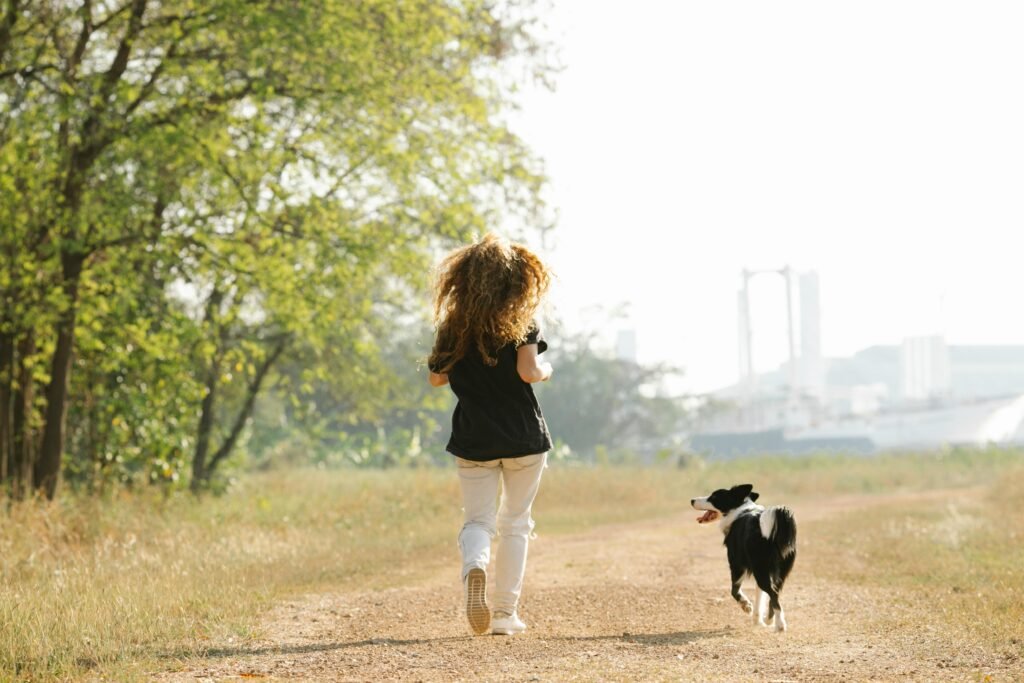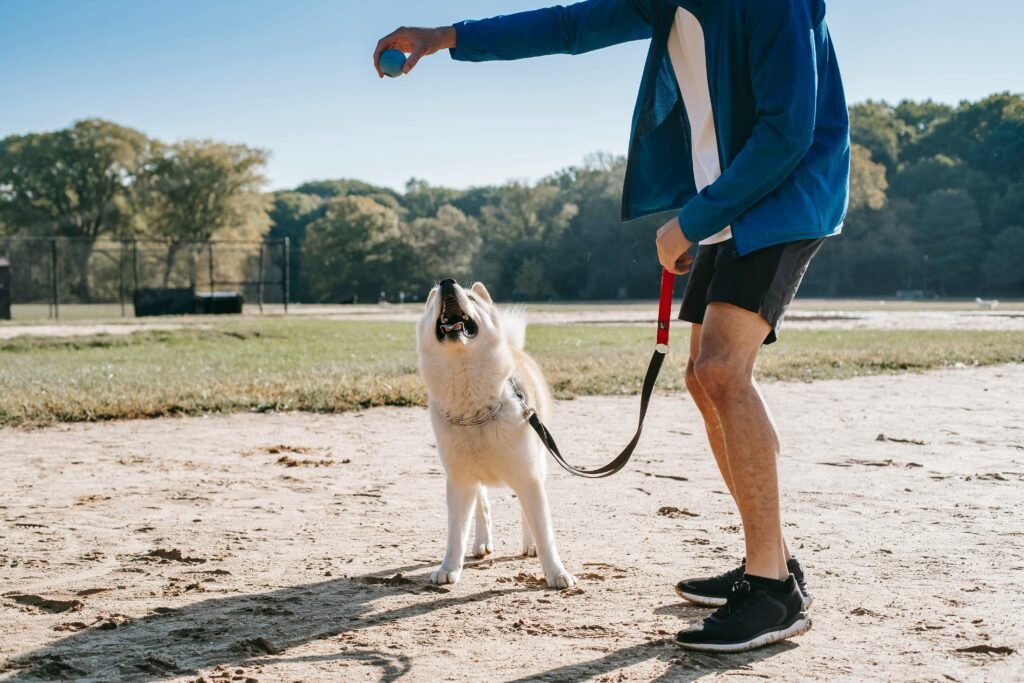Few commands are as vital for your dog’s safety and your own peace of mind as a reliable recall – teaching them to come to you instantly when called. Whether you’re in your fenced backyard, at a designated off-leash area, or dealing with the nightmare scenario of your dog accidentally getting loose, the ability to call them back to your side can be literally life-saving. Knowing how to train your dog to come when called is perhaps the most important gift you can give your furry family member.
For homeowners, especially, a dog that comes when called makes life much easier and safer. It means confident outings in the yard, safer interactions if the front door is accidentally left ajar, and the ability to quickly manage situations. It strengthens your bond and establishes you as a trusted leader.
If you’ve struggled with your dog playing hard-to-get, darting away, or simply ignoring you when you call their name, don’t despair! Teaching how to train your dog to come when called is achievable for any dog owner using positive, step-by-step methods. This guide will walk you through the process.

Why a Reliable Recall is the Most Important Command
While teaching ‘sit’ or ‘stay’ is useful, teaching your dog to come to you every single time you call them is paramount.
- Safety: This is the biggest reason. A solid recall can prevent your dog from running into a busy street, encountering dangers in the yard (like toxic plants or harmful objects), or getting lost.
- Freedom (in Safe Areas): A reliable recall allows your dog to enjoy more freedom in secure environments like a fenced yard or a designated off-leash park, getting essential exercise and mental stimulation. You can relax knowing they’ll return when you need them.
- Peace of Mind: Knowing you can call your dog back reduces anxiety for you in various situations.
- Strengthens Your Bond: Recall training, done positively, reinforces your dog’s positive association with coming to you. It builds trust and makes you the most exciting thing around!
- Easier Management at Home: Need your dog to come in from the yard quickly? Want them away from the door when guests arrive? A good recall simplifies these everyday scenarios.
Teaching how to train your dog to come when called isn’t just a trick; it’s a fundamental life skill for your dog.
Getting Started: The Fundamentals of Teaching How to Train Your Dog to Come When Called
Before we get into the steps, understanding the core principles behind successful recall training is vital. These apply every time you practice:
Make it FUN!
Coming to you should always be the most exciting and rewarding option available to your dog at that moment. Use an enthusiastic voice, get excited when they come, and celebrate their arrival!
Always Reward
Every single time your dog comes when called, especially in the early stages and when practicing in new places or with distractions, give them a reward. This should be a high-value reward – something they love and don’t get often (small pieces of cooked chicken, cheese, hot dog, or extra-special training treats). Praise is great, but high-value food is often the strongest motivator initially.
Never Punish Coming
If you call your dog and it takes them five minutes to finally get to you, do NOT scold or punish them when they arrive. If the consequence of coming to you is getting yelled at, they will learn not to come next time. Always make arrival a positive experience, even if you’re frustrated. (Address why they took so long by practicing in easier environments).
Start Indoors
Begin practicing in a distraction-free environment like your living room or a hallway. This allows your dog to focus solely on you and the command without tempting distractions like squirrels, smells, or other dogs.
Use a Unique Recall Word
While your dog’s name is important, consider using a specific word or short phrase just for recall (e.g., “Come!”, “Here!”, “To Me!”). This word should only ever be used for this positive exercise, not for calling them for something negative (like a bath or leaving the park).
Step-by-Step Guide: How to Train Your Dog to Come When Called
Let’s break down the process into manageable stages. Remember to move at your dog’s pace and make it enjoyable!
Step 1: The Name Game (Building Positive Association)
- Goal: Teach your dog that hearing their name (or your chosen recall word) means something good is about to happen.
- How: When your dog is close by and not distracted, say their name (or recall word) in a happy tone. The instant they look at you, give them a high-value treat and enthusiastic praise. Don’t call them to you yet, just reward the orientation towards you.
- Practice: Do this randomly throughout the day, 10-20 times in short bursts. Keep it fun and light.
Step 2: The “Happy Puppy” Recall (Excitement & Reward Indoors)
- Goal: Get your dog excitedly coming a short distance to you indoors.
- How: With your dog a few feet away in a quiet room, say your recall word enthusiastically. As they move towards you, get excited! When they reach you, generously reward them with treats and praise.
- Make it More Fun: Try crouching down, opening your arms wide, or using a slightly higher-pitched voice to sound inviting. You can also gently back away as they come to make it a fun chase game.
- Practice: Do many short sessions daily (5-10 repetitions per session). Gradually increase the distance slightly as they succeed.
Step 3: Increase Distance and Introduce Minor Distractions (Still Indoors)
- Goal: Get your dog reliably coming to you from across the room or when there’s a slight distraction.
- How:
- Distance: Practice calling them from across the house or from another room (start where they can still see you).
- Minor Distractions: Practice when someone else is in the room, or when there’s quiet background noise. Only increase distraction very gradually. If they fail, go back to an easier step.
- Always Reward: Every successful recall still gets a high-value reward!
Step 4: Move to the Yard (Fenced Area First)
- Goal: Introduce the outdoor environment in a safe, controlled space.
- How: Start in your securely fenced yard. Begin with minimal distractions. Practice the “Happy Puppy” recall (Step 2) here first. Call them when they are close by and not focused on anything else.
- Gradual Distractions: Slowly introduce minor outdoor distractions (e.g., practice when there’s a toy on the ground nearby, then when a family member is sitting quietly in the yard). Only progress if they are succeeding about 80% of the time.
- Use a Long Line (Optional but Recommended): If your yard isn’t fully escape-proof or you want extra security, use a long training line (15-30 feet) clipped to their harness (not collar). This allows you to gently guide them towards you if they get distracted or don’t come, preventing them from learning that they can ignore the command outdoors. Never let them reach the end of the line at a dead run.

Step 5: Introduce Real-World Distractions (Gradually and Safely)
- Goal: Get your dog coming when called in increasingly distracting environments.
- How: This is the hardest part and takes the most time and patience.
- Safe Environments: Continue using the long line in larger, securely fenced areas (like a dog park during off-peak hours when fewer dogs are around).
- Controlled Distractions: Practice with a friend and their calm dog at a distance. Gradually decrease the distance as your dog succeeds.
- Vary Locations: Practice in different fenced areas to help your dog generalize the command.
- High-Value Rewards: Use the best treats for this stage! Coming away from other dogs or exciting smells is a big deal.
- Never Risk Failure: If you’re not certain your dog will come in a highly distracting environment (like an unfenced area with wildlife), do not call them off-leash. Keep them safely leashed.
Step 6: Practice Consistently
- Goal: Maintain a reliable recall throughout your dog’s life.
- How: Even after your dog seems to have mastered recall, continue practicing regularly in various locations and with different levels of distraction. Keep it fun and continue using rewards (you can gradually transition to less frequent high-value rewards and more praise/play for dogs with a solid recall, but random high-value rewards keep it exciting!).
- Integrate into Play: Call your dog to you during playtime, reward, and then release them back to play. This prevents the recall word from only meaning “fun is over.”
Common Mistakes When Teaching How to Train Your Dog to Come When Called
Avoid these pitfalls, as they can severely damage your dog’s recall reliability:
Only Calling When it’s Time to Leave the Park/Fun
If the only time you call your dog is when you’re ending something fun (like leaving the dog park or the yard), the recall word becomes associated with negativity, not coming to you.
Punishing When They Eventually Come
As mentioned before, never scold a dog for taking a long time to come to you. They will learn that coming to you equals punishment, making them hesitant next time.
Calling When You Know They Won’t Come
If your dog is highly focused on something (like chasing a squirrel or playing intensely with another dog) and you know they are likely to ignore you, don’t waste your recall word. Every ignored command teaches them that the word is optional. Wait until they are less distracted or you can get closer before calling.
Progressing Too Quickly
Don’t move to a more distracting environment until your dog is reliably coming when called in an easier one (80-90% success rate). Setting them up for failure makes training harder for both of you.
Not Using High-Value Rewards
Especially when moving to more distracting areas, basic kibble might not be enough to compete with the environment. Use treats your dog finds exceptionally motivating.
Advanced Tips for a Rock-Solid Recall
Once the basics are mastered, try these:
Practice Around Different Distractions
Gradually introduce new types of distractions (people, sounds, smells, toys, other animals) in a controlled way, always rewarding success.
Play Recall Games
Games like “Hide and Seek” (in the house or fenced yard with family members) or “Ping Pong Recall” (two people calling the dog back and forth) make recall practice fun and reinforce the positive association.
Proofing the Behavior
Practice in various locations, at different times of day, with different people calling, and around increasingly higher levels of distraction to make the recall truly reliable in the real world.
When to Get Professional Help
If you are finding it very difficult to make progress, dealing with extreme distractions, or if your dog has a history of running away or shows fear/anxiety that impacts training, consider consulting a certified professional dog trainer or behaviorist. They can assess your specific situation, tailor a training plan, and help you overcome challenges.
Conclusion
Teaching how to train your dog to come when called is a fundamental part of responsible dog ownership and a cornerstone of a safe and happy life together. While it requires patience, consistency, and making the process fun and rewarding, building a reliable recall is absolutely achievable for most dogs and owners.
Start in a low-distraction environment, always reward your dog’s arrival enthusiastically, and gradually increase the difficulty. Avoid common mistakes like punishing their arrival or calling when you know they won’t come. By investing time in teaching how to train your dog to come when called, you gain peace of mind, allow your dog safe freedom in appropriate areas, and strengthen the incredible bond you share.
Begin practicing today – a reliable recall is the most valuable command your dog can learn!


